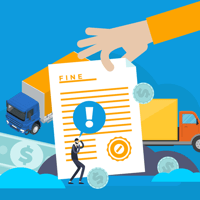Navigating the insurance world alone is certain to cause frustration and headaches. Plus, it takes...
5 Transportation Industry Predictions for 2022
As the end of 2021 rapidly approaches, one thing we can probably all agree on is what a pivotal year it has been as we collectively emerge from a global pandemic and try to sort out its aftermath. Our lives and our work have been impacted in the most profound ways, from how we attend school to where we work, to travel or not to travel, and, perhaps with the most significant impact on our economy, to shop or dine at brick-and-mortar stores. The alternative is, of course, that we can have virtually anything we want and need to be delivered to our doorstep, all made possible by the ever-evolving technology at our fingertips.
In some ways, it has never been easier to have takeout, groceries, prescriptions, pet food, or anything else delivered directly to our homes. Yet, we’ve all experienced the downside of this burgeoning at-your-doorstep lifestyle – shipping delays, items out of stock, or orders suddenly canceled due to a lack of resources in the supply chain. We’ve created an extreme demand for this new way of living and consuming so quickly that the supply chain is struggling like never before to keep up.
Because of this, contracting with independent contractors (ICs) is critical for businesses to keep up with the demands of the new normal. Finding and retaining quality ICs have always been top priorities for logistics companies, but the need is even greater now. As we review the hot button topics facing the transportation industry at this moment, and anticipate trends for 2022, one thing is for certain: the path forward to a more balanced and sustainable supply chain is through technology, with a relentless concentration on compliance at every step.
Prediction #1: The driver shortage will get worse.
It’s not exactly news that the driver shortage has had a significant impact on the transportation industry, especially during the pandemic. COVID, rideshare services, capacity, compliance requirements and even Amazon have been cited as the most complicating factors of the driver shortage. Further complicating the issue is the fact that the average age of truck drivers has been rising for years, resulting in more drivers exiting the industry and fewer young people attracted to transportation professions.
We now have data revealing what we can expect and should plan for in the future if the trend keeps going in this direction. Research conducted by the American Trucking Association has revealed the following:
- Currently, the American Trucking Association estimates the driver shortage to be 63,000, creating challenges for most, if not all, transportation companies.
- Looking ahead, we should expect a shortage of 105K drivers by 2023 and 160K by 2028.
- With 81% of domestic transportation tonnage being handled by truck, and a 36% increase in total tonnage from primary freight shipments (from 14.6B in 2020 to 19.9B in 2031), shippers are scrambling to find drivers to deliver this massive volume of tonnage.
Increased capacity demand is fueling the driver shortage and it is not going away anytime soon. The demand for IC drivers will continue to escalate, making driver recruiting the highest priority for the day-to-day operations managers.
Openforce’s recent polling shows that recruiting is one of the biggest transportation industry challenges. However, these organizations are beginning to shift their focus to adopting driver sharing for route density and partnering with third parties for attractive benefits. There is no indication that expedited delivery companies plan to adopt a W-2 workforce model.
Prediction #2: Proposed legislation changes will cause disruptions; but won’t stop IC driver momentum.
The recent shift in the political landscape means that transportation companies that utilize an independent contractor workforce need to shore up their business model. Any new legislation can present challenges, but that will not stop most transportation companies from utilizing a 1099 workforce.
Although the Protecting the Right to Organize (PRO) Act was passed by the House of Representatives on Feb. 6, 2020, it was never passed by the Senate. President Biden has been a vocal proponent of the PRO Act, but Blue Dog Coalition members are concerned that the codification of the ABC test would be a huge economic problem for their constituents. While the future of this legislation is unknown, in a recent poll, Openforce found 70% of respondents expect to be using an IC workforce in five years, despite legislation such as AB5 and the “ABC test”.
For transportation companies to remain successful despite legislation, they will need to focus on changing their business model to meet the compliance elements born out of any legislation or court ruling. They will also need to concentrate more on 1099 workforce compliance, which Openforce’s research indicates they plan to do. A full third of respondents (33%) are planning to implement a new tech platform to help manage their 1099 workforce with another third (33%) also considering driver sharing programs that help ensure IC drivers are generating multiple streams of income, which leads to clearer compliance.
Prediction #3: Rate increases will become necessary to survive.
Capacity demands mean that for the foreseeable future, rate increases will become necessary for transportation companies to survive.
COVID has created such capacity demands that, for the first time in 50 years, companies are publicly acknowledging they will not take on new customers. And if they can take on new customers, it comes at a premium.
For example, pricing structures within the courier and express delivery service segments have seen price increases of nearly 10% in the past year because of strong market demand (2021 Premium Report on Couriers & Express Delivery Services).
Rate increase discussions are happening everywhere, but there is not yet clarity on what they mean for retailers and carriers. But one thing is certain, increased delivery rates will propel inflation to even higher levels.
More than half of respondents (55%) to Openforce’s polling note they will increase their cost, with 44% doing so to eliminate low-paying customers and 11% citing they must increase prices or risk going out of business. Interestingly, those that will not increase their rates come at it from different points of view, with 22% noting they don’t need rate increases because they will inherit customers from competitors that do. An equal 22% say they will lose customers if they increase their rates. Respondents reported that their customers' biggest concern about rate increases was that the carrier maintains pre-COVID, on-time delivery percentages. They also said that rate increases have caused some customers to leave for lower-cost providers, sacrificing on-time performance.
Prediction #4: Transportation companies are investing in technology.
Just as people in their everyday lives are relying more on technology and making purchases via apps instead of at the checkout counter, transportation companies are starting to realize how investing in tech, or better tech, will set them up for success during these unprecedented times. Their customers, underwriters, and investors are making new tech investments, and logistics companies have no choice but to improve their management platforms in order to compete.
Expert industry veterans are expecting logistics companies to focus on integrating systems and using full-service TPA offerings equally (both coming in at 40%). Another option, though it comes with greater cost and potentially less domain knowledge, is to hire additional in-house technology staff (20%).
Prediction #5: The future of the transportation industry is at the mercy of increasing insurance rates.
As transportation demands continue to rise and qualified drivers are in shortage, more people without formal transportation training are raising their hands saying, “Sure, I'll drive.” But if these well-intentioned people are not properly vetted, operating in compliance with transportation laws, or properly insured to protect themselves, their cargo, their vehicles, and those they encounter when driving and delivering, this puts multiple parties at risk. And risk equals higher insurance rates.
Insurance is not a guarantee for any IC – it’s time-consuming to deal with, it’s an extra cost, and it’s not always top of mind to secure the right insurance coverage. ICs are their own business owners, so the only protection they have is what they choose to take on for themselves. Insurance is an “all boats rise in the tide” situation: improperly insured drivers cause all logistics insurance rates to increase. This means that both transportation companies and ICs alike need to be educated on the importance of removing risks through insurance. Insurance in the transportation industry is still a gray area with issues to resolve, especially deciding on the fiscal responsibility for proper insurance. Typically, inexperienced drivers have higher insurance rates. And we already know that many drivers are retiring, leaving it to younger individuals to pick up the slack. So, who pays the difference?
The reality is not all transportation companies are compliant with insurance, which is reflected in pricing to the customer. If all transportation companies were locked down and compliant, all RFPs would be more steadied across those competing, and retailers would not be forced to raise rates so substantially to consumers.
Being locked into long-term expensive insurance policies can be a big hurdle for independent contractors, which is why insurance providers need to offer coverages that are affordable and flexible, with convenient options that have no individual underwriting. ICs should have the option to pay premiums based on the work performed, so they are only billed for settlement periods for which they have provided services. Most insurance carriers are slow to gravitate to this concept, but there are a few forward-thinking carriers that are moving the concept forward and will, hopefully, inspire the rest of the industry.
The transportation industry is clearly overwhelmed right now; yet there are eager business owners, operations managers, dispatchers, drivers, and supply chain labor continuing to show up and work diligently to keep our country and our local communities moving forward. We need to support our ICs through education and benefits to keep their businesses thriving. Transportation companies need to embrace and implement better technology platforms to help them manage their daily operations and mitigate risk. Together, we will chip away at the transportation industry’s mountainous challenges and work to achieve a sustainable and profitable balance between supply and demand.



